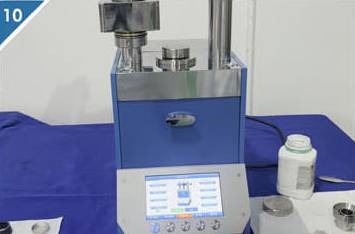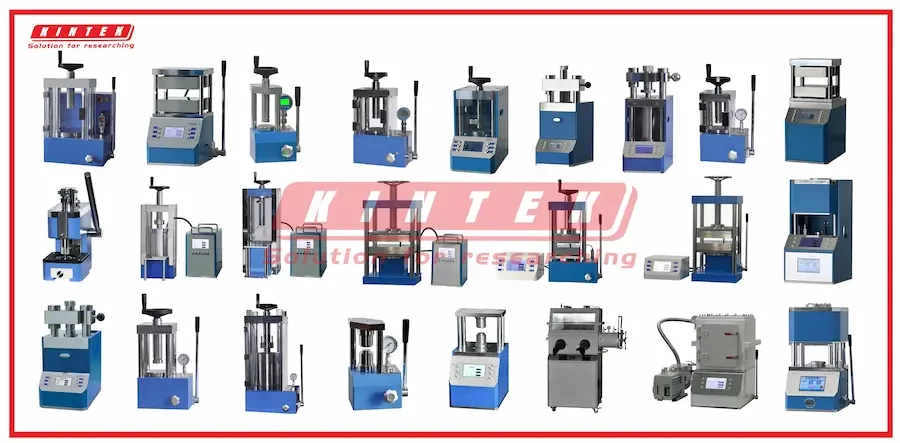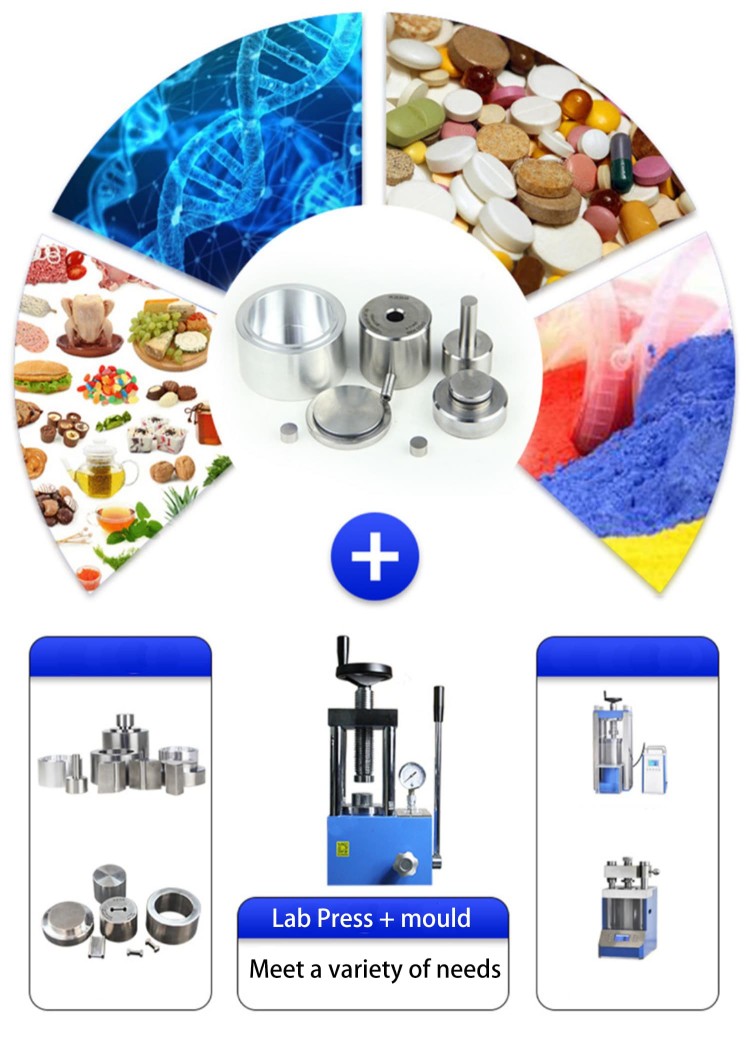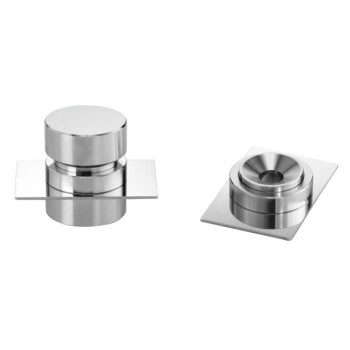
Electric Lab Press
Automatic Laboratory Hydraulic Press for XRF & KBR Pellet Press
Item Number : PMXA
Price varies based on specs and customizations
- Working pressure
- 0-60 T
- Sample size
- φ30-φ60 mm
- Release method
- Automatic release
Shipping:
Contact us to get shipping details Enjoy On-time Dispatch Guarantee.
Why Choose Us
Reliable PartnerEasy ordering process, quality products, and dedicated support for your business success.
Applications
The XRF(X-ray Fluorescence Spectrometry) technique can be used to determine the elemental composition of a sample with a high degree of accuracy.
The KinTek xrf pellet press is a great option for those looking for a fast and easy way to prepare pellets of solid samples for X-ray fluorescence analysis or infrared spectroscopy. This pellet press is able to produce both solid and highly permeable pellets, which makes it a versatile option for a variety of applications. Additionally, the pellet press is designed to be easy to use, so that you can get the most out of your samples.
A set of fluorescent molds is built in the press.
and the pressure program of the mold is automatically converted. It has the advantages of automatic pressurization/slow pressurization, automatic pressure holding, timing pressure relief, and automatic demoulding. It has the characteristics of beautiful appearance, strong practicability, and high safety.
Feature
- The pressure program of the mold is automatically converted. It has the advantages of automatic pressurization/slow pressurization, automatic pressure holding, timing pressure relief, and automatic demoulding.
- Small footprint, light weight, easy to carry and move, nice fitting vacuum glove box.
- High precision digital pressure gauge.
- Pressure can be programmed, hydraulic will restart working when pressure drops to set value.
Detail & Parts


- Automatic: Fully automatic desktop tablet press, programmable pressurization, easy operation and other advantages, suitable for high-end laboratories.
- Efficiency: Simplify the loading/ejection process. Shorten operating time and improve work efficiency
- Display: LCD screen display, the operation is more intuitive and the display is clearer. Convenient for users to operate.
Operation interface

- Standard interface: You can set various parameters, pressure, demolding, time, sample size, etc. in this interface.
- Pressure button: Press according to the parameters set in the interface.
- Stop button: Press the stop button to stop the pressurization during the pressurization process.
- Demolding button: Press the demolding button to demold the sample according to the demolding pressure.
- Timer switch: You can turn the timing function on and off.

- Start button: You can pressurize according to the multi-stage pressurization program.
- Stop button: During the pressurization process, you can stop the pressurization process.
- Set button: Click the setting button to enter the setting menu.

- List/Curve: You can switch between list and curve display.
Advantages
- The upper plate adopts electroplated countersunk head hexagonal screws, beautiful and space-saving
- Chrome-plated cylinder, smooth surface, no rust, good sealing rubber ring, no oil leakage
- One-piece main board structure, oil pool, main board, oil cylinder in a body, no seal connection
- Extended pulling spring, good rebound effect, not easy to deformation, can achieve the cylinder 30mm return without deformation
- All aluminum alloy hand wheel, beautiful, practical, not easy to break
- Small size, light weight, no oil leakage, can be used in the glove box
- Mold using Japanese high-speed steel, good material, high hardness, no deformation, long service life
- Digital display pressure gauge, more accurate pressure control, pressure display accuracy of 0.01MPa
- Oil pool outside the host, easy to replace the oil, and the oil circuit increased the hydraulic oil filtration device
- Special plunger, using special custom sealing structure, excellent sealing effect
- Pressurizing device, placed in the lowermost corner of the mainframe, the angle is reasonable, pressurizing force does not tilt back
Technical specifications
| Instrument model | PMXA-30T | PMXA-40T | PMXA-60T |
|---|---|---|---|
| Pressure Range | 1-30.0 tons | 0-40.0 tons | 0-60.0 tons |
| Pressurization process | Program pressurization - Program pressure maintaining - Timed pressure relief-Automatic sample withdrawal | Program pressurization - Program pressure maintaining -Timed pressure relief-Automatic sample withdrawal | Program pressurization - Program pressure maintaining - Timed pressure relief-Automatic sample withdrawal |
| Hold time | 1 second to 0 seconds | 1 second to 0 seconds | 1 second to 0 seconds |
| Pressure conversion | Program automatically converts the pressure borne by the mold | Program automatically converts the pressure borne by the mold | Program automatically converts the pressure borne by the mold |
| Display | 4.3 inch LCD screen | 4.3 inch LCD screen | 4.3 inch LCD screen |
| Metal buttons | Silver plated contacts with a service life ofover100000 times | Silver plated contacts with a service life of over100000 times | Silver plated contacts with a service life ofover100000 times |
| Built in mold | Boric acid/steel ring/plastic ring mold (built-in 1 set of mold) | Boric acid/steel ring/plastic ring mold (built-in 1 'set of mold) | Boric acid/steel ring/plastic ring mold (built-in 1 set of mold) |
| Sample size | Sample size standard configuration 40mm | Sample size standard configuration40mm | Sample size standard configuration40mm |
| Mold material | 440C mold steel | 440C mold steel | 440C mold steel |
| Demoulding method | Automatic stripping | Automatic stripping | Automatic stripping |
| Externaldimensions | 250×390×460mm(L×W×H) | 280×460×550mm(L×W×H) | 300×520×580mm(L×W×H) |
| Equipment power supply | 550W (220V/110 can be customized) | 550W(220V/110 can be customized) | 550W(220V/110 can be customized) |
| Equipmentweight | 120Kg | 150Kg | 180Kg |
| Dimensional diagram of powder tablet press | See picture below | See picture below | See picture below |

Operation steps
How to replace accessories and precautions

Step 1. Open the cantilever of the tablet press.

Step 2. Place the funnel into the mold cavity.

Step 3. Add the sample to the center of the funnel first.

Step 4. Sprinkle boric acid around the funnel.

Step 5. Use a hammer to spread the sample evenly.

Step 6. Close the cantilever.

Step 7. Select the pressure and time to be set.

Step 8. Enter and confirm the value.

Step 9. Click the pressurization button to start pressurization.

Step 10 Open the cantilever after depressurization.

Step 11. Click the demoulding button to start ejecting the sample.

Step 12. Take out the pressed boric acid sample.
Full range of lab press types

Click to view our full range of lab press products.
Any question? Our experts have helped many laboratories choose their lab press, contact us now!
Full range of types of laboratory press molds
We have a full range of molds for you to choose from, and the molds fit the body perfectly.
If you need molds with special shapes, we can also customize them for you.

Warnings
Operator safety is the top important issue! Please operate the equipment with cautions. Working with inflammable& explosive or toxic gases is very dangerous, operators must take all necessary precautions before starting the equipment. Working with positive pressure inside the reactors or chambers is dangerous, operator must fellow the safety procedures strictly. Extra caution must also be taken when operating with air-reactive materials, especially under vacuum. A leak can draw air into the apparatus and cause a violent reaction to occur.
Designed for You
KinTek provide deep custom made service and equipment to worldwide customers, our specialized teamwork and rich experienced engineers are capable to undertake the custom tailoring hardware and software equipment requirements, and help our customer to build up the exclusive and personalized equipment and solution!
Would you please drop your ideas to us, our engineers are ready for you now!
FAQ
What Is A Lab Press?
What Is The Purpose Of A Hydraulic Press In Lab?
What Are Different Type Of Lab Presses?
How Do You Prepare Pressed Pellets For XRF?
What Pressure Should XRF Pellets Be?
What Is The Advantage Of XRF Pressed Pellet Technique?
4.7
out of
5
This automated hydraulic press from KINTEK has revolutionized our laboratory workflow. It operates autonomously, allowing our technicians to focus on other tasks while it efficiently presses samples.
4.8
out of
5
The KINTEK XRF Pellet Press has been a game-changer in our laboratory. Its swift operations and integrated pellet dies have significantly reduced processing time and improved the consistency of our XRF measurements.
4.9
out of
5
The benchtop press from KINTEK has been an excellent addition to our lab. With its automatic and hand-operated models, we can customize it to our specific needs. The optional features have also enhanced its versatility and efficiency.
4.6
out of
5
The KINTEK Automatic Lab Press has been a lifesaver in our busy laboratory. It effortlessly handles large sample volumes, saving us time and effort. The automated features have also minimized the risk of human error.
4.7
out of
5
The KBR Pellet Press from KINTEK is a must-have for laboratories engaged in pharmaceutical, biological, and spectrographic operations. It's easy to use and produces high-quality pellets for various spectroscopic analyses.
4.8
out of
5
The KINTEK KT 400 Benchtop XRF Press has been an invaluable asset to our lab. Its user-friendly design, rapid pellet production, and safety features make it an exceptional choice for high-throughput XRF analysis.
4.9
out of
5
The KINTEK Automatic Hydraulic Press has transformed our laboratory's productivity. Its programmability, high precision, and durability make it an indispensable tool for pressing powders into solid pellets for XRF analysis.
4.6
out of
5
The KINTEK XRF Pellet Press has exceeded our expectations. Its compact design, portability, and ease of use make it an ideal solution for laboratories with limited space and resources.
4.7
out of
5
The KINTEK Benchtop Press has been a reliable workhorse in our laboratory. Its versatility, customization options, and user-friendly interface make it a valuable asset for various pressing applications.
4.8
out of
5
The KINTEK Automatic Lab Press has revolutionized our sample preparation process. Its automation, precision, and safety features have significantly improved our efficiency and reduced the risk of errors.
4.9
out of
5
The KBR Pellet Press from KINTEK has been a game-changer for our laboratory. Its ability to produce high-quality pellets for various spectroscopic analyses has enhanced the accuracy and reliability of our results.
4.6
out of
5
The KINTEK KT 400 Benchtop XRF Press has been an excellent investment for our laboratory. Its high-throughput production, user-friendly design, and safety features make it an indispensable tool for XRF analysis.
4.7
out of
5
The KINTEK Automatic Hydraulic Press has been a valuable addition to our laboratory. Its programmability, precision, and durability have significantly improved our efficiency in pressing powders for XRF analysis.
4.8
out of
5
The KINTEK XRF Pellet Press has been a lifesaver in our laboratory. Its integrated pellet dies and swift operations have streamlined our sample preparation process and improved the accuracy of our XRF measurements.
4.9
out of
5
The KINTEK Benchtop Press has been a game-changer for our laboratory. Its versatility, user-friendly interface, and customization options have enabled us to tackle various pressing applications with ease and efficiency.
4.6
out of
5
The KINTEK Automatic Lab Press has been a lifesaver in our busy laboratory. Its ability to operate autonomously has freed up our technicians to focus on other tasks, resulting in increased productivity.
4.7
out of
5
The KBR Pellet Press from KINTEK has been a valuable addition to our spectrographic operations. Its ease of use and ability to produce high-quality pellets have enhanced the accuracy and reliability of our analyses.
4.8
out of
5
The KINTEK KT 400 Benchtop XRF Press has been a lifesaver in our laboratory. Its high-throughput production and user-friendly design have significantly improved our efficiency in preparing samples for XRF analysis.
4.9
out of
5
The KINTEK Automatic Hydraulic Press has been a game-changer for our laboratory. Its programmability, precision, and durability have enabled us to achieve consistent and accurate results in pressing powders for XRF analysis.
REQUEST A QUOTE
Our professional team will reply to you within one business day. Please feel free to contact us!
Related Products

Automatic Laboratory Hydraulic Pellet Press Machine for Lab Use
Experience efficient sample preparation with our Automatic Lab Press Machine. Ideal for material research, pharmacy, ceramics, and more. Features a compact size and hydraulic press functionality with heating plates. Available in various sizes.

Laboratory Hydraulic Pellet Press for XRF KBR FTIR Lab Applications
Efficiently prepare samples with the Electric Hydraulic Press. Compact and portable, it's perfect for labs and can work in a vacuum environment.

Laboratory Manual Hydraulic Pellet Press for Lab Use
Efficient sample preparation with small footprint Manual Lab Hydraulic Press. Ideal for material researching labs, pharmacy, catalytic reaction, and ceramics.

Introducing the KINTEK KBR Press - a handheld laboratory hydraulic press designed for entry-level users.

Laboratory Hydraulic Press Lab Pellet Press Machine for Glove Box
Controlled environment lab press machine for glove box. Specialized equipment for material pressing and shaping with high precision digital pressure gauge.

Automatic Heated Hydraulic Press Machine with Heated Plates for Laboratory Hot Press 25T 30T 50T
Efficiently prepare your samples with our Automatic Heated Lab Press. With a pressure range up to 50T and precise control, it's perfect for various industries.

Laboratory Manual Hydraulic Pellet Press for Lab Use
Efficient Manure Lab Hydraulic Press with Safety Cover for sample preparation in material research, pharmacy, and electronic industries. Available in 15T to 60T.

Laboratory Hydraulic Press Lab Pellet Press for Button Battery
Efficiently prepare samples with our 2T Button Battery Press. Ideal for material research labs and small-scale production. Small footprint, lightweight, and vacuum-compatible.

30T 40T Split Automatic Heated Hydraulic Press Machine with Heated Plates for Laboratory Hot Press
Discover our split automatic heated lab press 30T/40T for precise sample preparation in material research, pharmacy, ceramics, and electronics industries. With a small footprint and heating up to 300°C, it's perfect for processing under vacuum environment.

Automatic Heated Hydraulic Press Machine with Heated Plates for Laboratory Hot Press
The Automatic High Temperature Heat Press is a sophisticated hydraulic hot press designed for efficient temperature control and product quality processing.

Laboratory Hydraulic Press Split Electric Lab Pellet Press
Efficiently prepare samples with a split electric lab press - available in various sizes and ideal for material research, pharmacy, and ceramics. Enjoy greater versatility and higher pressure with this portable and programmable option.

Manual Heated Hydraulic Press Machine with Heated Plates for Laboratory Hot Press
The Manual Heat Press is a versatile piece of equipment suitable for a variety of applications, operated by a manual hydraulic system that applies controlled pressure and heat to the material placed on the piston.

Heated Hydraulic Press Machine with Heated Plates Split Manual Laboratory Hot Press
Efficiently prepare your samples with our Split Manual Heated Lab Press. With a pressure range up to 40T and heating plates up to 300°C, it's perfect for various industries.

Heated Hydraulic Press Machine with Heated Plates for Vacuum Box Laboratory Hot Press
Enhance your lab's precision with our lab press for vacuum box. Press pills and powders with ease and precision in a vacuum environment, reducing oxidation and improving consistency. Compact and easy to use with a digital pressure gauge.

Heated Hydraulic Press Machine with Heated Plates for Vacuum Box Laboratory Hot Press
The lab press for vacuum box is a specialized piece of equipment designed for laboratory use. Its main purpose is to press pills and powders according to specific requirements.

No Demolding Lab Infrared Press Mold for Laboratory Applications
Effortlessly test your samples with no demolding required using our lab infrared press mold. Enjoy high transmittance and customizable sizes for your convenience.

Explore versatile Hydraulic Hot Press molds for precise compression molding. Ideal for creating various shapes and sizes with uniform stability.

Vacuum Hot Press Furnace Machine for Lamination and Heating
Experience clean and precise lamination with Vacuum Lamination Press. Perfect for wafer bonding, thin-film transformations, and LCP lamination. Order now!

Round Bidirectional Press Mold for Lab
The round bidirectional press mold is a specialized tool used in high-pressure molding processes, particularly for creating intricate shapes from metal powders.
Related Articles

A Comprehensive Guide on Pressing XRF Pellets Using a KinTek Automatic Hydraulic Press
XRF (X-ray fluorescence) analysis is a powerful technique used in various industries for material analysis. One crucial step in the XRF analysis process is the preparation of high-quality XRF pellets. These pellets serve as the sample for analysis and need to be properly pressed to ensure accurate results.

Operating of Automatic Lab xrf Pellet Press
How to use the Automatic Lab xrf Pellet Press, including steel ring, plastic ring, boric acid mold

Understanding the Technical Aspects of Cold Isostatic Pressing
Cold isostatic pressing (CIP) is a technique used in the manufacturing industry to achieve high-density materials with uniform properties. It involves applying equal pressure from all directions to a powder compact, resulting in improved compaction compared to traditional cold pressing methods.

Understanding Cold Isostatic Pressing (CIP) and Its Advantages
Cold Isostatic Pressing (CIP) is a unique technique used in the manufacturing industry for compacting and shaping materials. It involves subjecting a material to uniform pressure from all directions, resulting in a highly dense and uniform product. CIP is particularly useful for machining and metal forming tools, as well as for large parts that don't require high precision.

Understanding Cold Isostatic Pressing: Process, Comparisons, and Applications
Cold isostatic pressing (CIP) is a method of processing materials that involves compacting powders by enclosing them in an elastomer mold. The process is based on Pascal's law, which states that pressure applied in an enclosed fluid is transmitted in all directions throughout the fluid without any change in magnitude.

Automated laboratory XRF and KBR pellet press operating procedures
Introduction to automated laboratory XRF and KBR pellet press operating procedures.

Guide for Xrf Pellet Press
An XRF tablet press is a machine used to prepare samples for X-ray fluorescence (XRF) analysis by pressing them into a uniform tablet or pellet form.

What is xrf analysis and how to making pressed xrf pellets
What is xrf analysis and how to making pressed xrf pellets, there are also some precautions in the xrf sample preparation process

Effective Preparation of Samples for XRF Analysis via Pressed Pellets Method
The process of making pressed pellets for XRF analysis is a popular and widely used method. It offers several advantages over other sample preparation techniques. Pressed pellets have a higher signal-to-noise ratio compared to loose powder samples, allowing for the detection of even the lightest elements.

Why Your Sample Prep Fails: The Hidden Flaw in Your Hydraulic Press
Frustrated with cracked pellets and inconsistent lab press results? Discover the hidden material flaw in your equipment and how to fix it for good.

How to Choose the Right XRF Pellet Press for Your Needs
X-ray fluorescence (XRF) analysis requires the preparation of uniform, high-quality pellets for accurate analysis. To achieve this, there are several XRF pellet preparation methods available, including hydraulic, manual, and automated presses.

An In-Depth Guide on Laboratory Presses and KBr Pellets Production
In the world of scientific research and analysis, laboratory presses and KBr pellet production play a crucial role. These tools are essential in the preparation of samples for various analytical techniques, such as infrared spectroscopy and XRF spectroscopy.